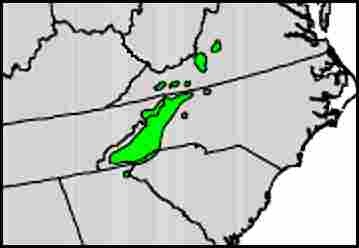Carolina Hemlock
(Tsuga caroliniana)
Carolina Hemlock is a mid-size coniferous tree native to the southern Appalachian region. Somewhat smaller than other hemlocks, it typically grows 40 to 70 feet tall with a slender trunk and a narrow crown of slightly drooping branches. It has flat evergreen needles, and in the fall it bears narrow cones about 1.5 inches long.
Like other members of its genus, this tree grows best in a cool moist climate. In cultivation it has proven to be more tolerant of city pollution and drought than its relatives. Its narrow pyramidal form and lustrous evergreen needles make it a desirable landscape plant. It is particularly attractive in winter when its branches are covered with snow.
Because of its limited occurrence, the species has little commercial value. But in the areas where it grows, it is valuable to wildlife. Birds eat the small seeds and nest in the thick cover of its branches. Deer browse the branches and use them for shelter in winter.
As a landscape plant, Carolina Hemlock is quite tolerant of shade, but will also do well in sun. It is slow-growing, but long-lived, and eventually gets fairly large, though it can be kept small by pruning. A special cultivar called "Compacta" stays under 20 feet without pruning.
This plant is threatened by the hemlock woolly adelgid, an insect believed to have come from Asia. In the past two decades a number of wild trees have died. Researchers are working on ways to combat the threat, but the ultimate fate of the species is uncertain.
Other Information
Scientific Name: Tsuga caroliniana
Common Name: Carolina Hemlock
Plant Type: Mid-size evergreen coniferous tree
Height: 40 to 70 feet
Cultivation Zones: 5 - 8
Native Habitat: Mountain slopes and ridges in mixed forests
Native Range: Mid elevations of the southern Appalachian mountains. See distribution map below.
Distribution Map

Range Map Source: U.S. Forest Service. (See General Note C)
Conservation Status: NatureServe lists Tsuga caroliniana as Critically Imperiled in Georgia, and Vulnerable in North Carolina and Tennessee.
Cultivation: Carolina Hemlock does best in a moist acid well-drained soil, though in a cool climate it can also grow on a drier site. It survives in shade but grows faster and has a better form in sun. Unless you need to prune it to keep it small, allow it to grow naturally with its branches sweeping the ground. A row of such trees makes an attractive large-scale screen or hedge. Seeds require 30-60 days of cold stratification. Go to Cultivation for more information.
Related Species: The only other hemlock native to the east is the Canadian Hemlock (also called Eastern Hemlock), which has a much larger range, from Georgia to Canada. It is a popular landscaping plant, but ultimately gets quite large. Other hemlocks are found in the western U.S. and Asia.
Plant Sources: Tsuga caroliniana can be difficult to find. Try Forest Farm, Shooting Star Nursery, and Nearly Native Nursery. Possible sources of seeds include F. W. Schumacher Company and Sheffields Seeds. For links to the mentioned suppliers, go to Sources of Plants.
Photos
|

